Shoulder Replacement
The shoulder is a “ball-and-socket” joint made up of the upper arm bone (the humerus), shoulder blade (the scapula) and collarbone (the clavicle). This joint is one of the most flexible joints in the body and allows for a full range of motion, but also makes the shoulder a common source of injury and instability.
While many shoulder conditions can be effectively managed through non-surgical techniques, surgery is often needed to adequately address severe arthritis and correct the condition. Surgery can allow patients to restore an active and healthy life. Total shoulder replacement is a procedure to replace the damaged cartilage within the shoulder joint in order to relieve pain in patients with arthritis. The procedure may also be performed in patients who have rotator cuff tear arthropathy or avascular necrosis, although Dr. Kaper will opt for a different approach if the glenoid bone has sustained too much damage. In some cases, Dr. Kaper may only replace the ball and leave the glenoid socket untouched, especially if it is still in good condition. The implant itself may be a simple press-fit bone cap if the humeral integrity is good, but may need to use bone cement to ensure attachment if it is not in good shape. If the glenoid socket is indeed replaced, it is usually a complete plastic replica of the area that fits along the chosen ball snugly.
Since 2005, the option of a Reverse Total Shoulder Replacement has become available in the USA. Originally designed by an American surgeon from Philadelphia, clinical experience initially occurred in Europe. In this procedure, the normal "ball and socket" joint is "reversed" to create a "socket and a ball" (see Patient 3 x-rays below). This surgery is indicated for patients with severe arthritis who no longer have a functional rotator cuff- a condition known as Rotator Cuff Arthropathy. Other indications for this very specialized procedure include patients with severe fractures of the humeral head and proximal humerus; or patients requiring revision of previous shoulder replacement surgery.
For questions about shoulder replacement surgery or to schedule a consult with Dr. Kaper, call us at (480) 305-0034 or book an appointment online through the link provided on our homepage.
Patient Photos
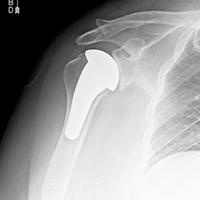
Patient 1 - Post-operative Right partial Shoulder Replacement (Front View)
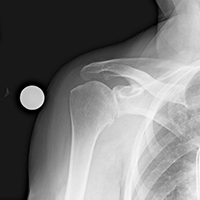
Patient 2 - Pre-operative Right Shoulder (Front view)
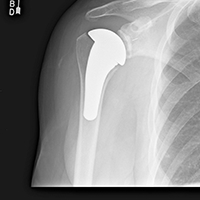
Patient 2 - Post-operative Right Total Shoulder Replacement (Front View)
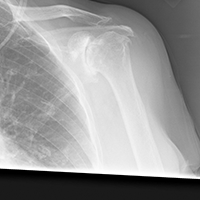
Patient 3 - Pre-operative Shoulder (Front View)
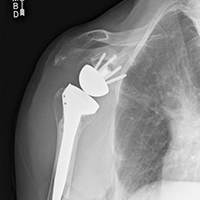
Patient 3 - Post-operative Reverse Total Shoulder Arthroplasty
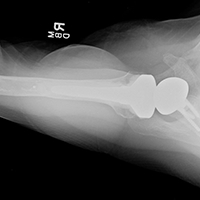
Patient 3 - Post-operative Reverse Total Shoulder Arthroplasty
The Economics of Shoulder Replacement Surgery
More and more patients are getting involved with the economic side of medicine- as I believe they should since the patient is the ultimate consumer of the healthcare product. My office strives to be as transparent as possible with regard the cost of my surgical procedures. Surgical procedures are billed through the use of a nationally established set of codes, known as the Common Procedural Terminology or CPT for short.
Total Shoulder Arthroplasty (TSA, including Reverse TSA) is billed as CPT code 23472; Shoulder Hemi-arthroplasty is CPT code 23470; Revision Shoulder Arthroplasty (one component- ball or socket revision) is CPT code 23473; Revision Shoulder Arthroplasty (both ball and socket) is CPT code 23474. Shoulder Arthroplasty is also routinely performed with stabilization of the Biceps tendon, known as a Biceps Tenodesis- this may be billed as a separate and additional CPT code 23430. Although this information can be confusing, knowledge of these codes is helpful to patients in order to understand the foundation from which surgical billing is determined. Surgeon fees will vary. Often the reimbursed amount is determined by the contract between the surgeon and your insurance company. In addition to the surgeons' fee, additional charges will be incurred in the entire surgical process. These include surgical assistant fee, anesthesiologist fee, hospital fee and physical therapy fee. If you would like to know more or have specific questions about medical costs, please do not hesitate to contact my office billing and insurance specialist.
Guidelines for Prophylactic Antibiotics after Shoulder Replacement
For most patients, use of prophylactic antibiotics after shoulder replacement is not necessary.
For patients with conditions that may suppress their immune system, including diabetes, cancer diagnoses, or use of certain immuno-suppressive medications, routine dental prophylaxis, one dose of Keflex or Amoxicillin, 2 grams orally, taken one hour prior to dental work is recommended.
For patients with allergies to Penicillins, we recommend Clindamycin 600 mg orally.



